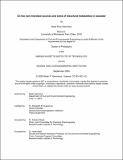| dc.description.abstract | Dissolved marine metabolites are small (<1000 Da) organic chemicals that remain in seawater when passed through a filter (typically <0.2 µm pore size). Their name implies their biological function: to be produced and consumed by cellular metabolism. These chemicals are the flows of the “microbial loop”—the principle that most of the photosynthesized matter in the ocean is exchanged, respired, and restructured by single-celled organisms. Metabolites have critical biological utility, so they are considered extremely labile; estimates of the time each spends outside cells range from hours to days. Their concentrations are drawn down by their consumers to nanomolar and picomolar levels, making measurement difficult. However, improved techniques to measure metabolites simultaneously and at extremely low concentrations avail the question of what happens to metabolites outside the cell membrane. Conventionally, representations of labile DOM exchange networks avoid that question—metabolites’ short lifetimes imply their flows lead from one organism to the next. This thesis begins to interrogate that assumption, asking if there are other processes that could change the seawater exometabolome on time scales that are relevant to microbial life. In Chapter 1 I discuss the ways ambient metabolite pools could be affected by animals, chemistry, and physics. In Chapter 2 I investigate the photolysis of metabolites and examine metabolomic techniques’ suitability for such experiments. In simulated sunlight, 11 of 57 metabolites decayed to some extent in artificial or natural seawater, and tryptophan and kynurenine may decay rapidly in the mixed layer of an oligotrophic ocean. For Chapter 3, I captured five species of migratory zooplankton and measured metabolites in their dissolved excreta. Four species survived the experiment and produced 43 metabolites, many at a rate that should be measurable in field samples. Chapter 4 harnesses the previous two chapters, plus a model for physical mixing, to probe a field dataset comprising 60 metabolites from Hydrostation S (south of Bermuda). Based on eight profiles over the course of two days, I posit: (1) copepods alone can supply the entire demand of >20 compounds to the mixed layer; (2) mixing is rapid enough to erase input signatures in the mixed layer; and (3) photochemistry is a slow leak of metabolites to forms whose lability is yet unknown. Chapter 5 reflects on how metabolites break the microbial loop—and suture it together with more ecological richness than with elemental fluxes alone. | |
